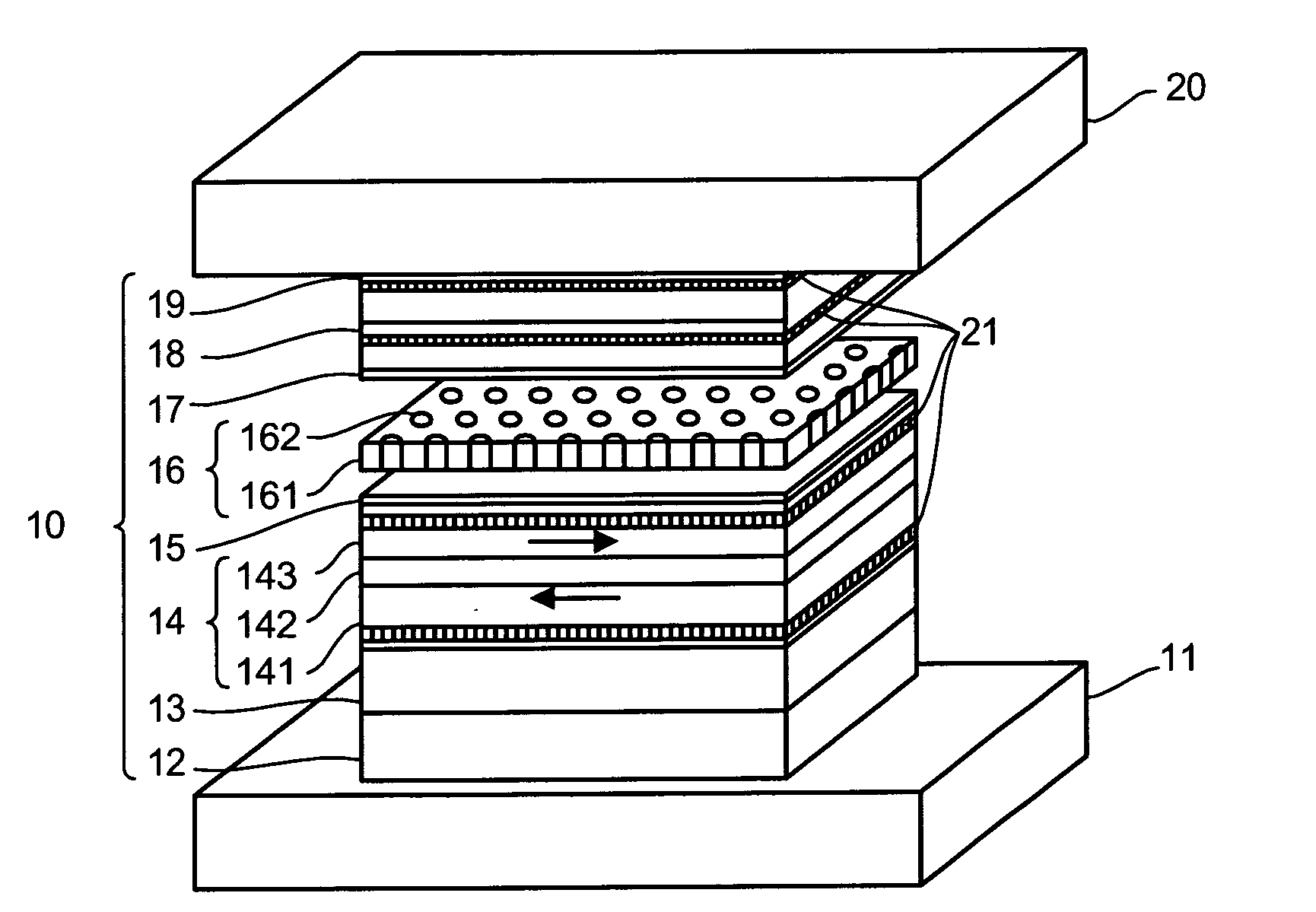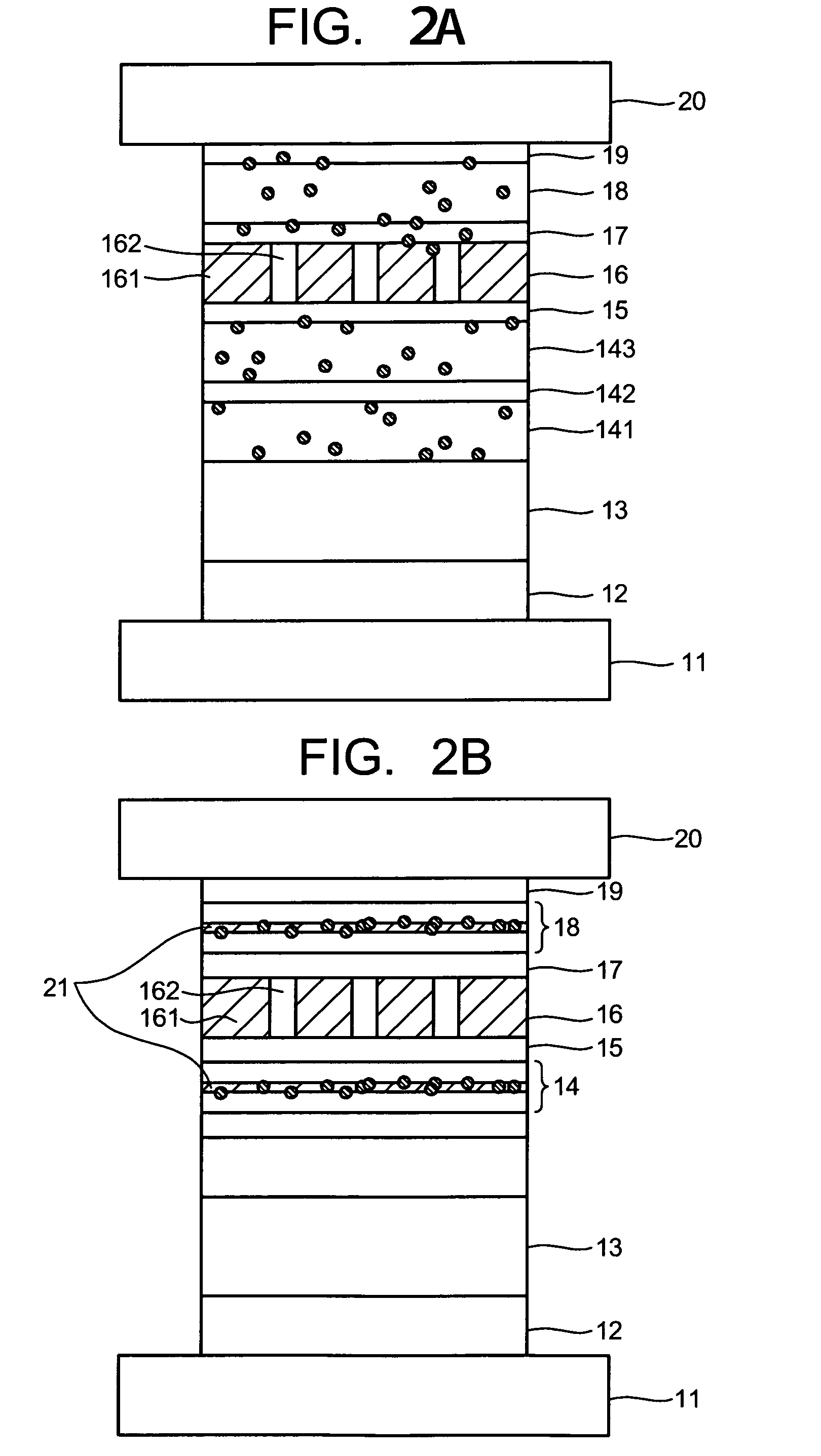Magneto-resistance effect element, and method for manufacturing the same
- Summary
- Abstract
- Description
- Claims
- Application Information
AI Technical Summary
Benefits of technology
Problems solved by technology
Method used
Image
Examples
example 1
[0156]In this embodiment, the film structure was configured below.
Bottom electrode 11Underlayer 12Ta 5 nm / Ru 2 nmPinning layer 13Ir22Mn78 7 nmPinned layer 14Co75Fe25 3.3 nm / Ru 0.9 nm / Fe50Co50 1 nm / Cu 0.25 nm × 2 / Fe50Co501 nmMetallic layer 15Cu 0.6 nmCurrent confining layer 16insulating layer 161 ofAl2O3 and current confining path 162 of CuMetallic layer 17Cu 0.4 nmFree layer 18described laterCap layer 19Cu 1 nm / Ta 2 nm / Ru 15 nmTop electrode 20
[0157]In this embodiment, the characteristics of the magneto-resistance effect element was investigated with and without the functional layer in the free layer 18. Example 1 corresponds to the magneto-resistance effect element with the functional layer and Comparative Example 1 corresponds to the magneto-resistance effect element without the functional layer. The results are listed in Table 2.
TABLE 2MRvariationFree layer 18ratio [%]Example 1Co60Fe40 [2 nm] / functional layer Si [0.25 nm] / 10.5Ni83Fe17 [3.5 nm]ComparativeCo60Fe40 [2 nm] / Ni83Fe17 [3...
example 2
[0159]In this embodiment, the functional layer was formed at various positions of the free layer 18 and the cap layer 19. The fundamental film structure will be listed below.
Bottom electrode 11Underlayer 12Ta 5 nm / Ru 2 nmPinning layer 13Ir22Mn78 7 nmPinned layer 14Co75Fe25 3.9 nm / Ru 0.9 nm / Fe50Co50 1.8 nm / Cu 0.25 nm / Fe50Co501.8 nmMetallic layer 15Cu 0.6 nmCurrent confining layer 16insulating layer 161 ofAl2O3 and current confining path 162 of CuMetallic layer 17Cu 0.4 nmFree layer 18described laterCap layer 19described laterTop electrode 20
[0160]The thickness of the pinned layer 14 of the film structure in Example 2 is larger than the thickness of the pinned layer 14 of the film structure in Example 1. If the thickness of the pinned layer 14 is set larger, the crystallinity of the top pinned layer 143 is enhanced so as to enhance the MR through the enhancement of the spin dependent bulk scattering effect. The film structure of the free layer 18 and the cap layer 19 will be listed in...
example 3
[0162]In this embodiment, the functional layers were formed in the pinned layer 14 and the free layer 18. The fundamental film structure will be listed below.
Bottom electrode 11Underlayer 12Ta 5 nm / Ru 2 nmPinning layer 13Ir22Mn78 7 nmPinned layer 14described laterMetallic layer 15Cu 0.6 nmCurrent confining layer 16insulating layer 161 ofAl2O3 and current confining path 162 of CuMetallic layer 17Cu 0.4 nmFree layer 18described laterCap layer 19Cu 1 nm / Ta 2 nm / Ru 15 nmTop electrode 20
[0163]The film structure of the pinned layer 14 and the free layer 18 will be listed in Table 4. In Example 3, the Si functional layer is formed in the top pinned layer 143, which is different from Example 2. The results are listed in Table 4.
TABLE 4MRvariationPinned layer 14Free layer 14ratio [%]Example 3Co75Fe25 [3.9 nm] / RuCo60Fe40 [2 nm] / 12.8[0.9 nm] / Fe50Co50 [0.6 nm] / functional layer Si [0.25 nm] / functional layer Si [0.25 nm] / Ni83Fe17 [3.5 nm]Fe50Co50 [1.2 nm] / Cu[0.25 nm] / Fe50Co50 [1.8 nm]Example 2ACo...
PUM
 Login to View More
Login to View More Abstract
Description
Claims
Application Information
 Login to View More
Login to View More - R&D
- Intellectual Property
- Life Sciences
- Materials
- Tech Scout
- Unparalleled Data Quality
- Higher Quality Content
- 60% Fewer Hallucinations
Browse by: Latest US Patents, China's latest patents, Technical Efficacy Thesaurus, Application Domain, Technology Topic, Popular Technical Reports.
© 2025 PatSnap. All rights reserved.Legal|Privacy policy|Modern Slavery Act Transparency Statement|Sitemap|About US| Contact US: help@patsnap.com



